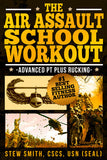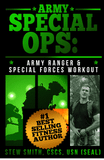The Differences Between the Air Force and Navy Special Warfare Initial Fitness Test (IFT) and Physical Screening Test (PST)
There are far more similarities than differences with these two fitness tests and follow on selection training, but there are some differences that have confused people throughout the years especially as both groups tend to change names, order of exercises, and standards quite often.
Training for both fitness tests as well as the follow on Prep Courses, Assessment and Selection programs are near identical with a few difference - for instance.
Both require a swim, run, pullups, pushups, and situps, but in different order / rest periods, standards, and the Air Force uses 500m as a distance and the Navy uses 500yds.
Make sure you know what the length of the pool is measured in as you may not be able to swim 10 laps to get your test completed. For instance 450m = 500yds so if in a meter pool, the Navy only swims 9 laps. If in a yard pool, the Air Force candidate needs to swim almost 11 laps (546 yds = 500m).
The Air Force can also use the freestyle stroke if candidates prefer. The Navy is limited to Breast Stroke, Elementary Side Stroke, Combat Side Stroke which is just a modified side stroke with a cool nickname. I have always referred to it as the Combat Swimmer Stroke.
See chart for distinctions: PST and IFTStandards as of 2020
*IFT is the new name for the Air Force PAST (old test name)
Minimum Initial Fitness Test (IFT/PST) for Air Force Special Warfare and Navy Special Warfare (SEALS)
|
AF IFT EVENTS |
SWOE: |
Navy PST EVENTS |
Navy SEAL Candidates Scores |
|
Pullups 2 min |
8 |
500yd swim |
12:30 |
|
Situps 2min |
50 |
Pushups 2 min |
50 |
|
Pushups 2 min |
40 |
Situps 2 min |
50 |
|
1.5 mile run |
10:20 |
Pullups 2 min |
10 |
|
2 x 25m u/w swim |
Pass/fail |
|
|
|
500m swim |
15:00 |
|
10:30 |
|
The most important similarity with the PT Test and the follow on training programs is you cannot be a good student with these minimum standards. These are JUST MINIMUM standards however, no one makes it through on minimum standards. You need to be better. In fact, I personally would strive for the following standards on either test: 500yd / 500m swim – 8:20 (a meter or yard per second pace) |
|||
See links for official pages with scores needed for other pre-enlistment options that are part of Special Warfare / Special Operations:
* AF EOD and SERE have different standards
* Navy SWCC, Diver, EOD, and Air Rescue have different standards
The Air Force requires 2 x 25m underwater swims for the IFT - the Navy PST does not. But, BUD/S and PJ training will require a 50m underwater swim during the early weeks of training.
As you can see the order of the events is different therefore requiring a different strategy for both. Swimming first then doing all the other events as in the Navy requires practice, perfect technique, and a fueling strategy if you want to have energy for the PT and run events.
Transition times can be helpful with being recovered for the next event, When you practice your tests or arrange your workouts, consider this test order to help you get used to the demands of the events. See Navy SEAL PST Clinic for how I recommend people to create strategies for this test. The same type of strategy would apply for the IFT with similar hydrating, transitioning movements, and fueling for the events.
The Air Force transition time from the land to the pool is 30 minutes. The transition from the PT exercises to the run is 10 minutes.
The Navy transition time from the pool to the land is 10 minutes. Same for transitioning from the PT exercises to the run.
The Combat Swimmer Stroke with Fins
NAVY Method - You can use the arms to pull and can be timed with your breathing. Top leg always goes forward when doing flutterkicks / scissor kicks though you may find the smaller flutterkicks work better than a big scissor kick and little flutters in between. Your choice how you do to.
Air Force Method - You use a Lead Arm / Trail Arm Side Stroke Method so you cannot move your arms during this LATA Side Stroke swim in the Air Force.
Pool Skills
At both BUD/s and the AFSW Assessment and Selection Courses and especially following training (especially PJ), you will be doing a lot of swimming (with / without fins), no hand treading, weighted treading, underwater swims, and some hardcore water competency training. Drown proofing, treading, multiple underwater swims, and snorkel buddy breathing are the killers at Air Force training. Whereas at BUDS, you will also have drownproofing, instructor life saving (aka underwater wrestling), underwater knot tying on breath holds (15ft deep), and as you master SCUBA diving in second phase, you will have Pool Comp (OC8) which is also underwater wrestling to a degree on SCUBA.
Both programs (Air Force and Navy Special Warfare) have recruiting programs that will test your abilities while in the Delayed Entry Program (DEP) and you should be able to crush these tests with some basic preparation and testing focus. Once you have passed the test, now you need to get good enough to be well over the minimum standards as well as focus on other events you will encounter such as longer swims, pool skills, longer runs, rucks, and other load bearing activities.
Special Ops Level Tactical Fitness Training Ideas
Learn How to do Seasonal Periodization to Build Tactical Athlete Skills
Twelve Questions / Answers About Mental Toughness
Quitting or Not Quitting - The Choice is YOURS
Getting TO and THROUGH Training (Two Phases of Tactical Fitness)
But see WHICH PROGRAM IS RIGHT FOR ME?

Who is Stew Smith? Coach, Trainer, Author, Podcaster: I'm the former Navy SEAL that special ops candidates go to for books, ebooks and online coaching to prepare themselves to get to and through intense tactical assessment and selection programs and qualify for service in their chosen tactical profession. See More at StewSmithFitness.com
Where to Find More Information About Optimal Performance Training Programs
When you start training again, consider the seasonal tactical fitness model. I call it A WAY to train and obviously not the only way to train. But it offers the opportunity to never neglect your weaknesses, helps with flexibility and mobility, but will also put you at a level of physical abilities where you are happy with your overall ability to just about anything. We have a systems where the seasons dictate our training. When it is nicer outside, we tend to run and do more calisthenics. When it is colder and not so nice, we lift more, run, less, and still maintain our outdoor activities with shorter runs and rucks. Check it out: Seasonal Tactical Fitness Periodization System.
My most recent programs that walk you through these four cycles with 12 weeks of each season in two programs.
These Seasonal Tactical Fitness BLOCK Periodization programs will walk you through 4 x 4 weeks cycles with 16 weeks of each season in two programs. (32 total weeks)

The Specific Military / Special Ops Physical Fitness Workouts Where Optimal Performance Will Be Tested Each Day
Navy SEAL Workout Phase 1
Navy SEAL Workout Phase 2 - 3
Navy SEAL Workout Phase 4 Grinder PT
Navy SWCC Workout



Army PFT Workout (Prep For Rucking, OPAT, ACFT)
Army Special Forces / Ranger Workout
Army Air Assault School Workout
Army Airborne Workout





Advanced Running Program - Special Ops Supplement Plan
USMC RECON / MarSOC Workout
USMC OCS / TBS Workout
USMC IST and PFT
The Combat Conditioning Workout
Air Force PJ / CCT Workout Battlefield Airman Prep Course
The UBRR Upper Body Round Robin Workout / Spec Ops version
The Coast Guard Rescue Swimmer / Navy SAR Workout
The Service Academy Workout (West Point, Navy, Air Force Academy)
The Navy, Air Force, Marine Corp Boot Camp Workout
The Law Enforcement Physical Fitness Workouts
The FBI Academy Workout | FBI Workout Vol 2
The DEA Workout
The FLETC Workout - Ace the PEB
The PFT Bible: Pushups, Sit-ups, 1.5 Mile Run
The Fire Fighter Workout - Ace the CPAT
Online Coaching Options
Online PT CLUB - Weekly Workouts created personally for you.
New Member's Only Content / Services Program!
If you want access to years worth of workouts, many of the top eBOOKs, favorite workouts of the week, free fitness APP, closed Facebook Group, video / picture library of exercises, and more access to LIVE Q/A sessions check out the Stew Smith Fitness Members Section.
The dashboard below has the links to all the information, archives, videos, and links to workouts, podcasts, live Q and A lessons.
Consider this! - A Membership Program and Gain Access to Exclusive Content
(click for Fitness Club Dashboard - members only)
Questions? Just email - Stew@StewSmith.com
At StewSmith.com - List of Products and Services
- FREE Articles
- Podcasts and Swimming Videos (Youtube, TikTok, Instagram)
- eBooks
- Books and eBooks in PRINT
- Stew Smith Fitness Club membership site
- Online Coaching
Stew Smith Fitness



















